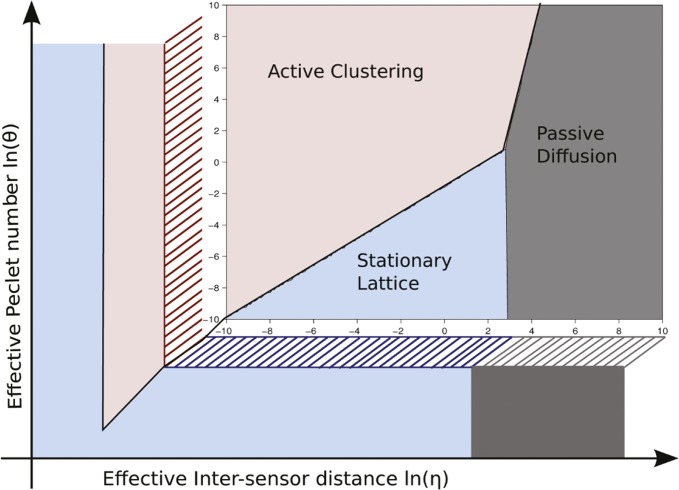Optimal chemical sensor configurations
Phase diagram depicting optimal cellular surface sensor configurations based on intersensor distance and Peclet number, a ratio of advection to diffusion.
Cell surface signaling receptors organize themselves into various architectures in different contexts to respond to cellular information processing needs. Garud Iyengar and Madan Rao (pp. 12402–12407) describe the trade-offs between clustering sensors to reduce estimation noise and distributing clusters to capture incoming signals that vary in space and time. The authors found that optimal sensor configurations are dependent on sensor density and sampling time, and that phase transitions divides three predominant sensor architectures. In an ideal model, stationary lattices of sensors such as those employed by Escherichia coli bacteria are optimal when the sensor density or spatial correlation length of the incoming signal is large. Active clusters of sensors, employed by eukaryotic cells, are ideal when sensor density and spatial correlation lengths are small. In a realistic stochastic model, the authors determined that a third phase, passive diffusion, may become ideal if the density of sensors is large enough to compensate for individual sensor noise and the ratio of the chemical advection rate to diffusion rate is sufficiently low. The results suggest that by organizing chemical sensors into ideal architectures depending on cellular needs, biological systems have developed solutions to information processing problems that may be applicable to human engineering and communications systems. — P.G.
Credit allocation on multiauthor papers
Determining an author’s contribution to a multiauthor scientific publication based on the ordering of author names on the manuscript is complicated by inconsistent ordering practices across disciplines. To identify how the research community perceives author contributions for publications across disciplines, Hua-Wei Shen and Albert-László Barabási (pp. 12325–12330) designed an algorithm that assigns credit based on coauthors’ contribution to the scientific literature in the field. The authors chose 63 research papers in the fields of physics, chemistry, medicine, and economics that were authored by a Nobel Prize winner and examined the citation lists of papers that later cited the 63 target papers. Credit was assigned to each author of the target papers based on the number of their previously published papers that appeared on the citation lists, weighted by the relevance of each paper to the target paper. Of the 63 papers analyzed, the algorithm correctly identified the Nobel Prize-winning author as the coauthor that the scientific community perceived as having had the most significant contribution in 86% of the papers. According to the authors, the algorithm may help accurately allocate credit to authors on multiauthor papers across disciplines. — J.P.J.
Human endogenous retroviruses and pluripotency
By overexpressing certain genes and transcription factors, adult somatic cells can be reprogrammed into an embryonic stem cell-like state known as induced pluripotency. Although induced pluripotent stem cells (iPSCs) are similar to embryonic stem cells (ESCs), roughly 10% of iPSC clones exhibit a defective phenotype that is unable to differentiate or maintain pluripotency. Noting that defective iPSC clones overexpress genes related to human endogenous retroviruses (HERVs), Mari Ohnuki et al.(pp. 12426–12431) found that HERV type-H is transiently hyperactivated in somatic cells during reprogramming and returns to comparable levels with ESCs once full pluripotency has been acquired. Using four defective iPSC lines, the authors also demonstrated that HERV type-H activation remains aberrantly high in the defective phenotype, thus leading to the cells’ inability to differentiate. Taken together, the findings suggest that the transient hyperactivation of HERVs represents a critical step in reprogramming somatic cells toward pluripotency and establishing differentiation potential, according to the authors. — T.J.
Laser pulse to identify chemicals from a distance

Ultrabright nature of random Raman lasing emission.
Researchers have long sought techniques to remotely identify materials, from finding organic compounds on distant planets in the search for extraterrestrial life to detecting nitrates used in explosives from a safe distance. Brett Hokr et al. (pp. 12320–12324) demonstrate how a single laser pulse can produce material-specific light from a target up to 1 km away. The authors’ technique relies on a well-established physical phenomenon known as Raman scattering, in which light passing through a material is scattered at the vibrational level of its molecules. Detecting this signal at a distance presents a major challenge, however, as only 1 in 10 trillion photons entering a material undergo spontaneous Raman scattering. Citing a recent advance in laser optics known as random Raman lasing, the authors describe how to apply Raman scattering in real-time from faraway objects. According to the authors, the approach can be used to distinguish between visually similar white powders at a distance of 400 m, potentially helping to identify explosives, hazardous chemicals, and biological materials from a safe distance. — T.J.
Parsing biological systems
Biological systems researchers have long lacked suitable tools for dissecting complex biological phenotypes. Few, if any, technologies can generate and track high-order combinations of genetic perturbations in a scalable fashion. Allen Cheng et al. (pp. 12462–12467) developed a method called Combinatorial Genetics en Masse (CombiGEM) to generate high-order barcoded combinations of genetic elements that can be characterized via next-generation sequencing technologies. The authors demonstrate the method’s utility by generating approximately 34,000 pairwise combinations of overexpressed Escherichia coli transcription factors and using CombiGEM to identify combinatorial genetic perturbations that enhanced the killing of carbapenem-resistant bacteria. Multiple combinations of transcription factors enhanced antibiotic killing by as much as 10^6-fold, revealing potential targets for antimicrobial development. Delivery of these combinations via phagemids increased the killing of highly drug-resistant E. coli harboring the New Delhi metallo-betalactamase-1. The study further revealed that three-wise combinations of transcription factors, with more than 4 million unique library members, could be tracked via next-generation sequencing. According to the authors, CombiGEM provides a useful tool for basic research and applied biotechnology, allowing researchers to perform complex genetic screening, identify novel drug targets, map interactomes, and characterize synthetic gene circuits. — A.G.
Gut bacteria in infants
Despite the importance of intestinal bacteria in health throughout life, little is known about how the newborn infant gut transitions from a state of complete or near-sterility to dense bacterial colonization within weeks of birth. Patricio LaRosa et al. (pp. 12522–12527) used DNA sequencing to analyze bacterial populations in 922 stool samples from 58 premature infants residing in the controlled environment of a neonatal intensive care unit. The authors found that bacteria in infants’ guts progressed through a choreographed succession of classes from Bacilli to Gammaproteobacteria to Clostridia, interrupted by abrupt population changes. Environmental factors such as antibiotics, vaginal vs. Caesarian birth, diet, and infant age when sampled influenced the pace, but not the sequence, of this progression. The results suggest that gut bacterial communities assemble in a nonrandom fashion and that the assembly may depend to a greater extent on gestational age at birth than on identifiable environmental factors, according to the authors. — B.A.



